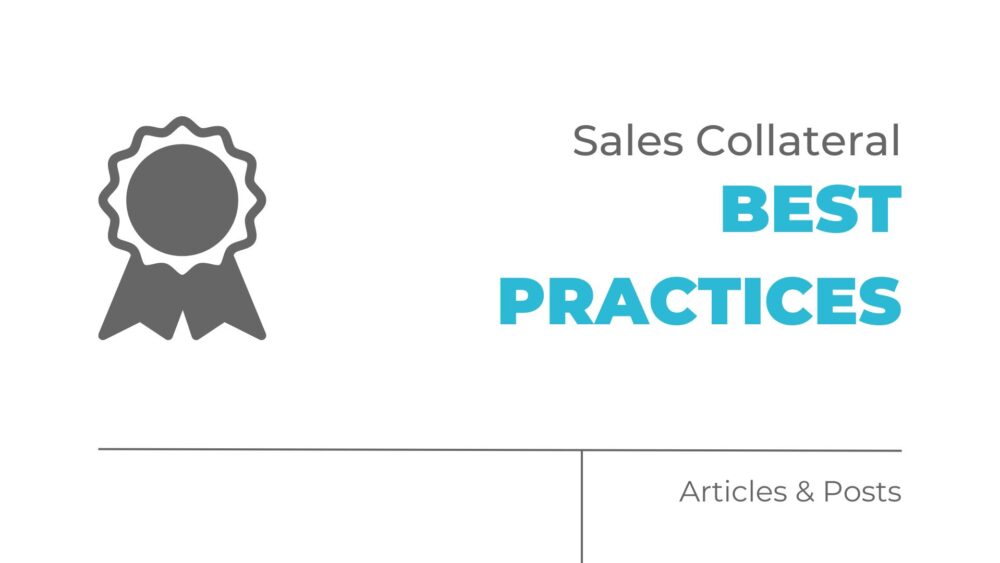Sales collateral best practices help make sure your marketing materials effectively support your sales process and persuade potential customers.
Good sales collateral is clear, engaging, and designed with the target audience in mind.
Here’s a guide to creating top-notch sales collateral that drives results.
What is a Good Sales Collateral?
Good sales collateral provides valuable information about your product or service, addressing the needs and pain points of your target audience.
It should be visually appealing, easy to read, and include a clear call to action that guides prospects to the next step.
Types of Effective Sales Collateral
There are various types of sales collateral that can be highly effective:
Brochures and Catalogs
These provide detailed information about your products or services. They are great for giving potential customers a comprehensive understanding of what you offer.
- Example: IKEA uses catalogs effectively to showcase their range of furniture and home goods. Their catalogs provide detailed images and descriptions, helping customers visualize products in their homes.
Case Studies
Case studies show real-world examples of how your product or service has helped other customers. They build trust and credibility by showcasing success stories.
- Example: HubSpot uses case studies to demonstrate how their inbound marketing software has helped businesses increase their leads and sales. These case studies include detailed accounts of customer challenges, solutions, and results.
White Papers and E-books
These documents delve deep into industry topics, offering valuable insights and positioning your company as an expert in the field.
- Example: Salesforce provides white papers and e-books on various aspects of customer relationship management (CRM) and sales strategies. These resources help establish Salesforce as a thought leader in the industry.
Presentations and Sales Decks
Used during meetings or pitches, these materials help communicate your value proposition in a visually engaging way.
- Example: Apple’s product launch presentations are famous for their clear, compelling storytelling and high-quality visuals. These presentations effectively communicate the benefits and features of new products to both media and consumers.
What is Good Marketing Collateral?
Good marketing collateral supports your overall marketing strategy and helps attract and convert leads.
It should be aligned with your brand, consistent in messaging, and targeted to your audience’s interests and needs.
Key Elements of Good Marketing Collateral
- Consistent Branding: Use your brand colors, fonts, and logos consistently across all materials.
- High-Quality Images: Include clear and professional images that support your message.
- Clear Layout: Make sure your design is clean and organized, making it easy for readers to find key information quickly.
- Engaging Copy: Write persuasive and relevant content that speaks directly to your audience’s needs and pain points.
Sales Collateral Best Practices Examples
Implementing best practices can significantly improve the effectiveness of your sales collateral.
Here are some examples to consider:
Know Your Audience
Understanding your audience is key to creating relevant and engaging sales collateral.
Research their demographics, interests, and pain points to create your materials accordingly.
Focus on Benefits
Highlight the benefits of your product or service rather than just listing features.
Explain how your offering can solve your customers’ problems or improve their lives.
Use Strong Calls to Action
Encourage your prospects to take the next step, whether it’s contacting you for more information, scheduling a demo, or making a purchase.
Clear calls to action guide them through the sales process.
Measure and Update Regularly
Track the performance of your sales collateral using metrics like engagement rates and conversion rates.
Regularly update your materials to keep them relevant and effective.
Leverage Digital Sales Collateral
Incorporate digital formats like landing pages, which are designed to capture leads or drive specific actions.
A well-crafted landing page can significantly increase conversion rates.
Key Elements of Effective Landing Pages
- Clear Headline: Your headline should immediately convey the value of what you are offering.
- Compelling Copy: Use persuasive language that speaks directly to your audience’s needs and desires.
- Strong Visuals: Include images or videos that support your message and attract attention.
- Call to Action: Have a prominent and clear call to action, such as “Download Now” or “Sign Up Today.”
At the End of the Day
Creating effective sales collateral involves understanding your audience, focusing on benefits, and maintaining consistent branding.
Regular updates and strong calls to action are essential to keep your materials relevant and engaging.
By following these best practices, you can improve your sales process and achieve better results.


Comments are closed.